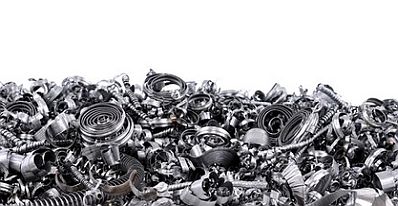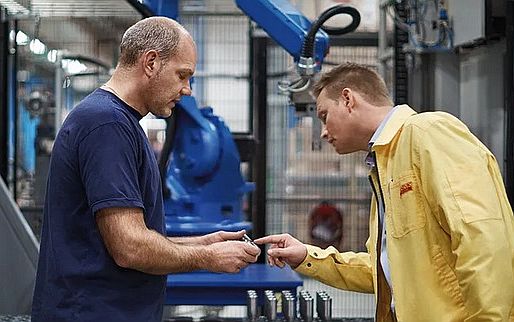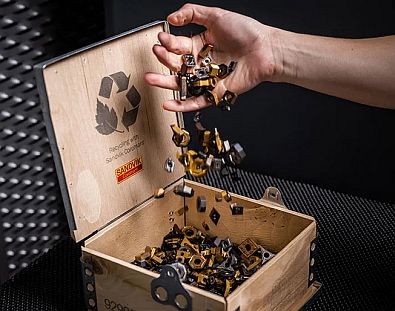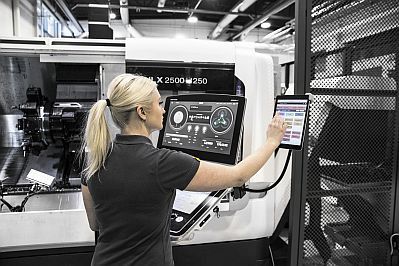Newest Methods and Technologies Help Manufacturers Machine Metals for People, Planet and Profit
Waste material, poor productivity and scrap components are all signs of an inadequate machining process. They're also signs of unsustainable machining. With the right tools and processes in place, many sustainability gains can be made when cutting metal. Matilda Gynnerstedt, Head of Product Management Turning at Sandvik Coromant, explores the tools and technologies that drive productivity, reduce waste and improve the sustainability of metal cutting.
Metals are the backbone of today's industrialized world. From steel in our buildings and aluminum in our cars, to titanium in modern aircraft and the copper found in electronics, metals are important building blocks in our economy. And their prevalence isn't going to dwindle.

If manufacturing is to power the new industrial revolution, it will need to take a holistic approach to sustainability, combining actions from shop floor to top floor.
As governments across the world implement plans to decarbonize, demand for renewable technologies will see our reliance on metals continue to soar. In fact, The International Energy Agency (IEA) Steel and Iron Technology Roadmap reports that global demand for steel will increase by more than a third between now and 2050.
But, as metal demand increases, so too will expectations on how metals are sourced, produced and used in manufacturing.
Making Progress
Producing metals has long been considered a carbon-intensive process. While it's true that steelmaking produces a lot of emissions, industry has made successful strides towards reducing its impact. Green steels, for example, replace coking coal, traditionally needed for ore-based steelmaking, with renewable electricity and hydrogen. This can drastically reduce carbon emissions during the metal production process.

Waste produced by industry, on a global scale, is 18-times more than solid waste produced by municipalities around the world.
While recent innovations, like green steel, could bring a more sustainable future for the metal industry, there are several other technologies that can make metalworking processes more sustainable. Manufacturers must become more aware of these methods if they are to tackle tomorrow's sustainability challenges.
The Right Tool for the Job
For machine shops and plants tasked with cutting difficult-to-machine metals into desired forms, with tight tolerances and the utmost surface quality, the right tools and expertise are essential. Specifically, the tool should aid a more efficient and less wasteful machining process, and support major sustainability benefits.

Sandvik's CoroPlus® PIP service monitors performance continuously, with monthly reports and proactive suggestions to ensure full realization of savings.
Scrapping components is a factor that prevents a workshop from achieving top performance. Common situations that lead to scrapping include using the wrong tools, human errors in machine programming and undetected variations in the raw material that cause unpredictable machining issues. Moreover, waste has a serious impact on the environment if it isn't recycled. In fact, World Bank estimates that waste produced by industry, on a global scale, is 18-times more than solid waste produced by municipalities around the world.
If manufacturers are to reduce scrap, they must implement the right tooling set-up and cutting data. Failure to secure these factors can result in irregular tool wear and unpredictable insert tool life -- this leads to component rejections and, in turn, scrap.
Tool choice is especially integral to reducing waste in turning, a common lathe machining operation. Efficient steel turning can be achieved by reducing scrap and component rejections, as part of an effective strategy to bring down the cost of production within an existing machining set-up. The strategy might include maximizing machine use or selecting more reliable tooling solutions, like the insert, to reduce cost per part.
But what are the characteristics of a more reliable tool?

Manufacturers looking to build a green factory should invest in measures that reduce scrap rates.
Turning grades that provide long and predictable tool life, with good chip control, should be considered for secure and productive machining. Selecting a tool with longer life, combined with greater wear and heat resistance, can yield tangible benefits like minimizing unplanned stops, or reducing material waste from the workpiece material or from the carbide insert itself.
These are all necessary preconditions for sustainable machining. Sandvik Coromant's dedication to using recycled materials in their turning grades is also an important factor in order to make a customer's productions more sustainable. One of the criteria in Sandvik's development project is to increase the use of recycled material as well as reduce waste.
Smoothing Out the Pain Points
While awareness of sustainability is gaining momentum across virtually all industries, so too is digital transformation. In a survey of more than 400 global manufacturing companies, 94% of respondents indicated that Industry 4.0 has helped keep their operations running during the pandemic. The challenges of COVID-19 have also served as a wake-up call to manufacturers who are lagging behind in implementing Industry 4.0 strategies.

Ultimately, aligning sustainability goals with your core business model will ensure their integrity, creating a connecting line between who you are and what you do.
The advantages of Industry 4.0 for manufacturers are now well-known -- that it helps managers and workers make better-informed decisions, leads to greater productivity, can reduce production errors and supports higher profits. But a lesser realized benefit of Industry 4.0 is the crucial role it plays in sustainability.
Historically, plant managers have based machining decisions on the initiative and experience of their workers. Machines that are connected through the Internet of Things (IoT), on the other hand, can enhance the invaluable experience of human workers to offer new possibilities for transparency, optimized planning and streamlined production. With this in mind, today, there are a number of digital services that can help manufacturers implement more sustainable production processes.
A good place to start in any sustainability strategy is to conduct an audit of a plant's current status with data-led insights. This approach can identify several areas of inefficiency that might impede a machine shop's productivity and sustainability. For instance, if a facility is experiencing premature tool wear, subpar surface finishes or high machine downtime, then data gathered through sensors can help operators make informed improvements to their machining process in ways that help reduce waste and increase energy efficiency.

CoroPlus® PIP is a service that brings an increase in productivity to your production cell or machine. By finding and then analyzing your pain points over a period of time, you are able to carry out data-based improvements on key areas in your production.
The CoroPlus® Productivity Improvement Programme (PIP) is one solution to these pain points. The PIP is a proven, structured process that can be performed on a single machine, a process chain, or across the whole plant.
To begin the process, Sandvik Coromant experts identify inefficiencies in production and then installs machine monitoring solutions that give data insights in real-time. This data can be accessed remotely to provide an in-depth analysis of a complete production cell, right down to the cutting tool.
CoroPlus® PIP can support manufacturers with lowering costs and reducing inefficiencies, but also helps make the manufacturing process more sustainable. By making sure machines run as efficiently as possible and cutting down machining time, the program can eliminate waste and reduce energy consumption. Not least, major assets -- the people on site -- will have better working conditions while knowing machine processes are smooth, stable and predictable.
A few misinformed decisions can be the difference between productive, sustainable metal cutting and a wasteful machining process. However, as we become more aware of the impact of metalworking on the environment, innovations are being realized that can significantly improve industry's credentials. That includes finding more sustainable ways of not just producing, but also machining metals for people, planet and profit.
Want more information? Click below.
Rate this article
View our terms of use and privacy policy ::m::